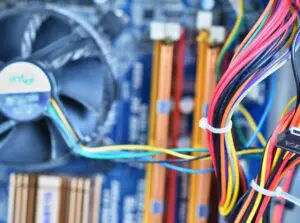You’re investing significant time, money, and resources into developing what should be a great product. Yet performance issues like intermittent failures and component breakdowns keep surfacing. If you’re troubleshooting these problems and coming up empty, there’s a strong possibility the root cause lies in your cable and wire harness design.
Too many companies treat wire harnesses as a simple afterthought in the design process, but this approach puts your entire product’s performance and reputation at risk. What might appear to be a minor design oversight can cascade into major product failures, warranty claims, and customer dissatisfaction.

(montypeter/Freepik)
What Happens When Cable and Wire Harness Design Falls Short?
When your cable and wire harness design has flaws, serious reliability issues emerge. These problems can cause significant performance degradation and costly downtime. For example, misrouted wires introduce electrical noise, poor shielding causes signal degradation, and improper strain relief creates short circuits.
You may also experience:
- Intermittent electrical faults due to poor crimping or solder joints
- Mechanical damage from wires being pinched or over-flexed
- Heat buildup caused by insufficient conductor sizing or improper bundling
The real danger is that many of these cable assembly issues don’t appear immediately. Your product might pass initial testing but fail once it’s out in the field, costing you in warranty returns, brand reputation, and customer trust.
Why Product Reliability Depends on Smart Harness Design
If you rely on a custom PCB, you probably optimize for size, signal integrity, and manufacturability. However, those efforts can be undone if your wire harness doesn’t match the same standard. The harness serves as the bridge between power and control, so it needs to be robust, consistent, and repeatable.
For instance, think about how poor harness design affects assembly. When wires are difficult to route or connectors don’t align properly, your production team wastes time making adjustments. Mistakes increase during these adjustments, raising the risk of rework or defective products reaching customers.
EMI (electromagnetic interference) problems also emerge when cables lack proper shielding or grounding. Additionally, harnesses without sufficient bend radius are prone to long-term fatigue and failure, particularly in applications with moving parts.
The High Cost of Cutting Corners
Trying to save a few dollars on harness design might seem smart in the short term, but it almost always backfires. You might face:
- Production delays from cables that are hard to install or test.
- Increased failure rates that drive up support and warranty costs.
- Lost customers who won’t tolerate reliability issues, especially in critical applications
In industries like medical devices, automotive, and industrial automation, even one failure can be catastrophic. That’s why you need to find cable assembly contract manufacturing partners with proven experience. These manufacturers know industry requirements and can deliver the traceability, reliability testing, and quality standards your product demands.
Harness Design Challenges You Can’t Ignore
Many of the challenges you’ll face in wire harness design aren’t immediately obvious unless you’ve been through multiple product cycles. Here are some common traps:
- Overcrowded routing paths: When multiple wires cram into tight spaces, they rub against each other, causing insulation damage.
- Lack of strain relief: Insecure cables allow connectors to loosen or fail over time due to mechanical stress.
- Ignoring environmental factors: Moisture, extreme temperatures, and vibration damage harnesses that lack proper protection, such as sealing, heat shrink tubing, or overmolding.
If you’re working with an external PCBA manufacturer or EMS PCBA partner, it’s critical that they understand these challenges and have processes in place to mitigate them. Otherwise, you’re left dealing with inconsistent quality and unnecessary failures.
How to Improve Wire Harness Design for Reliability
So, what can you do to prevent these issues? Start by designing your cable assemblies reliably. Focus on:
Collaboration early in the design phase: Bring your harness engineer, mechanical designer, and electrical engineer together at the beginning of the product development process. This ensures that routing paths, connection points, and electrical specs are aligned from day one.
Use proper materials and shielding: Choose wires, connectors, and coverings that match your product’s operating environment. Don’t settle for generic components if your device faces unique stressors.
Implement design for manufacturability (DFM): A well-designed harness is easy to build, install, and test. Design with your assembler in mind, especially if you’re working with a PCB assembly partner.
Also, make sure to document everything from wire colors to pinout charts to connector part numbers. Clear documentation helps avoid mistakes during production and supports traceability throughout your product’s lifecycle.
Working with the Right Manufacturing Partner
You can have the best harness design on paper, but if your EMS PCBA partner doesn’t have the capability or discipline to build it accurately, you’re still at risk. Look for a partner that:
- Offers in-house harness design support
- Follows IPC/WHMA-A-620 standards for wire harness quality
- Performs 100% testing on finished harnesses
You should also ask about their traceability practices. Can they tell you which technician built a specific harness? What batch of connectors was used? These details matter when you’re trying to eliminate quality escapes and reduce risk.
Even if you handle PCB design and assembly internally, outsourcing your cable harnesses to a specialized team can elevate your overall product reliability. You’ll benefit from their tooling, experience, and attention to detail.
Don’t Let Poor Design Sink Your Product
Poor cable and wire harness design creates serious liability for your product’s performance. From intermittent signal issues to premature connector failures, these issues directly impact your bottom line and customer satisfaction.
If you’re dealing with these problems, it’s worth taking a closer look at your harness design. How are your harnesses being assembled? What kind of testing is being done? Are corners being cut somewhere along the way?
Your cable assembly contract manufacturing partner should meet the same standards you expect everywhere else. When harness design gets the attention it deserves, your products work better and last longer.
